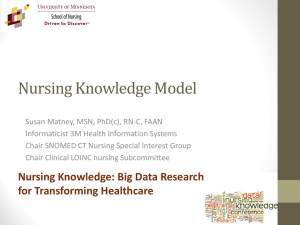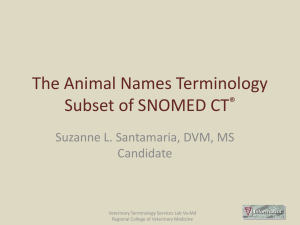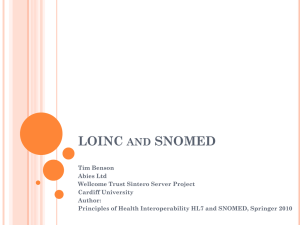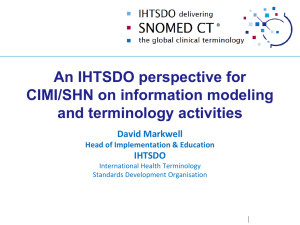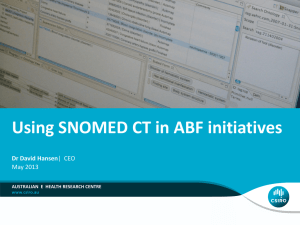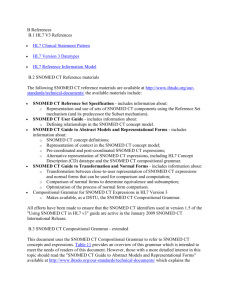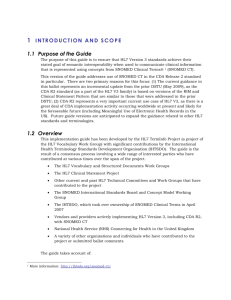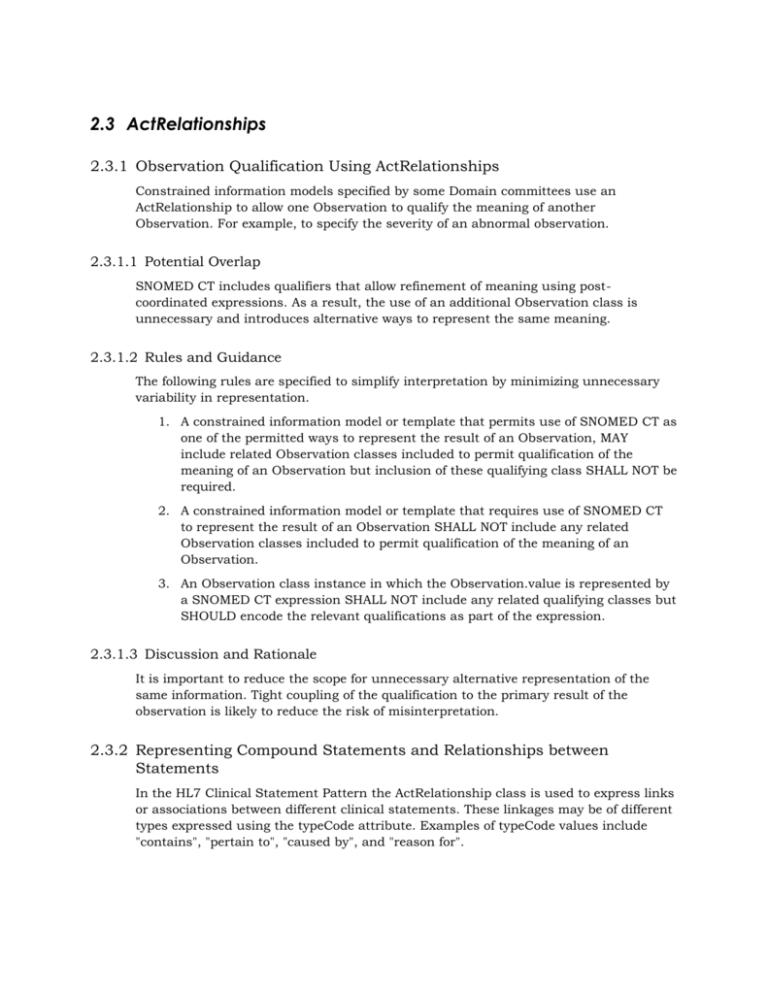
2.3 ActRelationships
2.3.1 Observation Qualification Using ActRelationships
Constrained information models specified by some Domain committees use an
ActRelationship to allow one Observation to qualify the meaning of another
Observation. For example, to specify the severity of an abnormal observation.
2.3.1.1 Potential Overlap
SNOMED CT includes qualifiers that allow refinement of meaning using postcoordinated expressions. As a result, the use of an additional Observation class is
unnecessary and introduces alternative ways to represent the same meaning.
2.3.1.2 Rules and Guidance
The following rules are specified to simplify interpretation by minimizing unnecessary
variability in representation.
1. A constrained information model or template that permits use of SNOMED CT as
one of the permitted ways to represent the result of an Observation, MAY
include related Observation classes included to permit qualification of the
meaning of an Observation but inclusion of these qualifying class SHALL NOT be
required.
2. A constrained information model or template that requires use of SNOMED CT
to represent the result of an Observation SHALL NOT include any related
Observation classes included to permit qualification of the meaning of an
Observation.
3. An Observation class instance in which the Observation.value is represented by
a SNOMED CT expression SHALL NOT include any related qualifying classes but
SHOULD encode the relevant qualifications as part of the expression.
2.3.1.3 Discussion and Rationale
It is important to reduce the scope for unnecessary alternative representation of the
same information. Tight coupling of the qualification to the primary result of the
observation is likely to reduce the risk of misinterpretation.
2.3.2 Representing Compound Statements and Relationships between
Statements
In the HL7 Clinical Statement Pattern the ActRelationship class is used to express links
or associations between different clinical statements. These linkages may be of different
types expressed using the typeCode attribute. Examples of typeCode values include
"contains", "pertain to", "caused by", and "reason for".
2.3.2.1 Potential Overlap
SNOMED CT provides a variety of attributes that can be used to represent relationships
between different concepts in a post-coordinated expression. These post-coordinated
expressions have the potential to represent some association that might alternatively be
represented using ActRelationships. For example, the attributes [ 42752001 | due to |]
could be used to construct expressions such as [ 49218002 | hip pain |: 42752001 |
due to | = 396275006 | osteoarthritis |], which could also be represented using two
separate Observations linked by an ActRelationship with the typeCode "caused by".
2.3.2.2 Rules and Guidance
There is no absolute rule about when to express linkage in the terminology and when to
use linkage mechanisms in the RIM (e.g. ActRelationships). However, the following
guidance should be followed:
A single identifiable observation, assertion or procedure SHOULD usually be
represented by a single Act class instance containing an appropriate SNOMED CT
expression.
A single Act class instance SHOULD be used to represent an integral combination of
facets applicable to a single identifiably observation, assertion or procedure. Some
examples of integral combination are shown below. The common feature of these is
that together they represent a finding with a distinct pattern and a shared life
history.
o
A combination of findings is a part of a single recognizable condition
o
A disorder is specialized by a specific cause
o
E.g. [ 51771007 | postviral fatigue syndrome |], "Shortness of
breath after moderate exercise".
A single recognized procedure involves two or more distinct but related
actions:
E.g. [ 4855003 | diabetic retinopathy |].
A temporal or causative relationship between two concepts in which one is
a specific symptom or diagnostic criterion for the other.
o
E.g. "Pneumonia due to streptococcus pneumoniae".
The nature of a disorder is determined by another condition
o
E.g. "Headache preceded by visual disturbance".
E.g. [86477000 | total hysterectomy with removal of both tubes and
ovaries |], "Reduction and fixation of a fracture"
Post-coordinated SNOMED CT expressions SHOULD NOT be used to artificially
combine distinct observations, assertions and procedures into a single Act class
instance.
o
The line between integral combinations of items and distinct items is not
clear-cut. However, as a general rule two items SHOULD be considered to
be distinct if
Page 2
HL7 V3 IG: TermInfo - Using SNOMED CT in CDA R2 Models, Release 1
© 2013 Health Level Seven International. All rights reserved.
January 2014
they are capable of being independently validated (i.e. the accuracy
of one statement is not dependent on the accuracy of the other)
their life histories differ and are independent of one another
the relationship between them is a matter of judgment rather than
fact
Distinct observations, assertions and procedures SHOULD be represented by
separate Act class instances related to one another by appropriate ActRelationships.
o
Multiple distinct findings in a patient that may or may not be associated
with one another or with some more general problem.
o
Multiple conditions occur contemporaneously (or in sequence) where the
nature of individual conditions is specific to the presence of the other
condition.
o
E.g. A collection such as "chest pain" with "shortness of
breath" finding of "tachycardia" and "ECG abnormality"
interpreted as "Myocardial infarction".
E.g. "AIDS" and "gastro-enteritis"
Multiple distinct procedures incidentally performed at the same time or
during the same hospital stay.
2.3.2.3 Discussion and Rationale
In general SNOMED CT expressions (whether pre-coordinated or post-coordinated) are
most appropriate for expressing multiple facets of a single logical concept. On the other
hand, HL7 ActRelationships are more appropriate for making associations between
multiple distinct observations or procedures. However, this boundary is fuzzy and there
are many situations in which either approach may have equal merit.
The use of SNOMED CT attributes may result in arbitrarily complex statements that
wrap multiple distinct findings within a single terminological expression. In these cases,
the use of separate coded statements linked by Act Relationships is preferable. On the
other hand, use of multiple statements linked by ActRelationships to represent a single
composite finding or procedure may result in loss of the natural clinical term used by a
clinician within a collection or linked classes.
Even when the guidelines above are followed, there will be grey areas. In an ideal world
a rule would be devised to compute equivalence between single Act class instances
containing a post-coordinated SNOMED CT expression and multiple Act class
instances. While this is theoretically possible, there are several practical obstacles. The
HL7 vocabulary for the ActRelationship.typeCode attribute differs from the range of
values for linkage attributes in SNOMED CT. Simple precise or close mappings exist for
some values but more work is needed before we can assert full semantic interoperability
between the two representations. In addition, while a single instance post-coordinated
representation has a single life-history the individual instances in multiple class
representation may have separate life histories and separate associations with other
contextual information.
HL7 V3 IG: TermInfo - Using SNOMED CT in CDA R2 Models, Release 1
Page 3
January 2014
© 2013 Health Level Seven International. All rights reserved.
2.4 Participations
2.4.1 Subject Participation and Subject Relationship Context
The HL7 participation type “subject” relates a finding or procedure to a subject who
may or may not be the subject of the record. This allows specific named individuals to
be identified as the subject of an Act. It can also be used to associate a related person
by specifying their relationship rather than by identifying them. For example [
303071001 | person in the family |], [ 72705000 | mother |], [ 70862002 | contact
person |], etc.
2.4.1.1 Potential Overlap
The SNOMED CT [ 408732007 | subject relationship context |] attribute provides a
mechanism for indicating that the subject of a procedure or finding is a person (or other
entity) related to the subject of the record. This facility is used to define some SNOMED
CT concepts (e.g. "family history of asthma" has [ 408732007 | subject relationship
context |] = [ 303071001 | person in the family |]). The same attribute can also be used
to create post-coordinated expressions. For example, it can be used to express a family
history of a disorder without requiring a pre-coordinated concept that expresses a
family history of that particular disorder. Unlike the HL7 "subject" participation, the
SNOMED CT mechanism does not directly support reference to an identified person.
2.4.1.2 Rules and Guidance
The following rules are specified to encourage explicit recording of the [ 408732007 |
subject relationship context |] in order to minimize risks of overlooking this aspect of
the information.
1. When using SNOMED CT to represent an observation or procedure that applies
to a subject other than the record target, the appropriate [ 408732007 | subject
relationship context |] SHOULD be specified in the SNOMED CT expression.
o
For example "family history" should be represented using an expression that
specifies the [ 408732007 | subject relationship context |] as [ 303071001 |
person in the family |].
2. The HL7 subject participation MAY also be used and SHALL be used if there is a
requirement to specifically identify an individual subject.
3. If the HL7 subject participation is used in addition to the SNOMED CT
representation of [ 408732007 | subject relationship context |], the Role.code of
the role that is the target of the subject SHOULD be represented using SNOMED
CT with the value applied to the [ 408732007 | subject relationship context |] or
with a subtype of that value.
2.4.1.3 Discussion and Rationale
These recommendations leave some situations in which either approach may be used.
Therefore, to compute equivalence, a map between the values used in the code attribute
of the associated subject role is required. The simplest option would be to specify that
when the classCode attribute of the HL7 Role specifies "personal relationship" the code
Page 4
HL7 V3 IG: TermInfo - Using SNOMED CT in CDA R2 Models, Release 1
© 2013 Health Level Seven International. All rights reserved.
January 2014
attribute should have a value from the SNOMED CT [ 408732007 | subject relationship
context |] hierarchy.
Ambiguity may be introduced if the information is coded using a concept with explicit [
408732007 | subject relationship context |] and also has an association to a specific
subject. For example, if the concept [ 160303001 | FH: Diabetes mellitus | ] is stated in
an observation linked to a person other than the subject of the record, this could mean
either (a) "the patient has a family history of diabetes, in the named family member" or
(b) "the identified subject has a family history of diabetes".
Specific recommendations on this should be included in communication specifications.
Where a communication pertains to an individual patient interpretation (a) is
recommended. However, specific instances of the subject participation in a
communication about a group of patients may need to specify interpretation (b).
2.4.2 Specimen Participation in Observations
The HL7 participation type “specimen” relates an observation to the specimen on which
an observation was made (or is to be made). The specimen participation allows type of
specimen or an actual identifiable specimen to be specified.
2.4.2.1 Potential Overlap
Some SNOMED CT [ <<386053000 | evaluation procedure |] and [ <<363787002 |
observable entity |] concepts indicate the type of specimen that is the subject of the
measurement or observed property. Refinement is possible using the [ 116686009 | has
specimen |] attribute to specify particular specimen types for any relevant procedure.
Therefore, there is a potential overlap between two approaches to representation of the
nature of the specimen.
2.4.2.2 Rules and Guidance
1. When using SNOMED CT to record an observation that applies to a specimen
the nature of the specimen MAY be expressed separately using the Entity.code of
the entity playing the role that is the target of the specimen participation
o
This type of representation may be appropriate in cases where it is also
necessary to identify the specimen and where a single specimen is the
subject of multiple different observations.
o
When using this form of representation:
The type of specimen SHOULD be expressed using an appropriate
SNOMED CT concept in the Entity.code attribute.
If the SNOMED CT expression used in Observation.code specifies a
value for the [ 116686009 | has specimen |] attribute, the value of
this attribute SHALL be either the same as or less specific than the
value used in the Entity.code.
2. Alternatively, a specific SNOMED CT concept or expression MAY be used to
specify the nature of the observation including the type of specimen.
HL7 V3 IG: TermInfo - Using SNOMED CT in CDA R2 Models, Release 1
Page 5
January 2014
© 2013 Health Level Seven International. All rights reserved.
o
This form MAY be appropriate to simple recording of result in a clinical record
but does not allow the specific instance of the specimen to be identified.
2.4.2.3 Discussion and Rationale
The recommendations on representation of specimen take into account the current
incomplete set of investigation codes available. Recent experience in the UK suggests
that the first approach above, using the Entity.code is a more flexible basis for
requesting and reporting laboratory investigation using SNOMED CT.
The guidance on use of SNOMED CT in the Entity.code attribute is intended to avoid
conflicts or ambiguity that may result from representing the values of [ 116686009 |
has specimen |] and Entity.code using different coding systems.
2.4.3 Product and Consumable Participations in Supply and
SubstanceAdministration
The HL7 product Participation associates a specified material (via an appropriate Role)
with the instance of the Supply class instance that delivers this material to a subject.
Similarly the "consumable" associates a specified material (via an appropriate Role) with
the instance of the SubstanceAdministration class instance that delivers this material
to a subject. In both these cases, the relevant Act class instance itself only needs to
specify the action involved and does not need to indicate the nature of the material
supplied or administered.
2.4.3.1 Potential Overlap
In SNOMED CT concepts that are subtypes of [ 432102000 | administration of
substance |] can also specify the nature of the substance administered. Refinement of
any particular type of administration is possible by applying values to the "direct
substance" attribute to represent administration of any pharmaceutical product.
Therefore, there is a potential overlap between two approaches to representation of the
nature of the substance administered.
2.4.3.2 Rules and Guidance
1. When using SNOMED CT to communicate about the supply or administration of
a substance the nature of the substance SHOULD be specified in the Entity.code
of the Entity associated with the Role that is the target of the relevant product or
consumable Participation. When using this form of representation:
o
the Act.code of the SubstanceAdministration class instance SHOULD be
coded using a SNOMED CT concept that is a subtype of [ <<432102000 |
administration of substance | ], but which does not specify a [
363701004 | direct substance |].
o
the nature of the substance administered SHOULD be expressed using an
appropriate SNOMED CT concept in the Entity.code attribute of Entity
playing the Role that is the target of the relevant participation.
Page 6
HL7 V3 IG: TermInfo - Using SNOMED CT in CDA R2 Models, Release 1
© 2013 Health Level Seven International. All rights reserved.
January 2014
Example: SubstanceAdministration.code= [ 36673005 | intradermal injection |]
with associated Entity (via a consumable Participation and an appropriate Role),
in which Entity.code=[ <<82573000 | lidocaine |] OR
2. When using SNOMED CT to summarize information about a particular type of
medication (e.g. use of a local anesthetic during a procedure), a SNOMED CT
expression that includes information about the nature of the substance
administered MAY be used. However, this form SHOULD NOT be used for
communicating about the prescription, supply or personal administration of
medication.
Example: SubstanceAdministration.code=[ 36673005 | intradermal injection |
363701004 | direct substance |<< 82573000 | lidocaine |]
2.4.3.3 Discussion and Rationale
The first approach follows the form recommended by the Pharmacy TC and endorsed by
the Clinical Statement Pattern and other domain committees. The alternative approach
may be relevant for summary notes related to certain types of treatment but is not
appropriate for prescribing or medication management as it does not provide a
reference to a specific quantifiable amount of the substances administered nor does it
allow reference to batch numbers and detailed product information.
2.5 Context Conduction
2.5.1 Structures which propagate context in HL7 models
CDA R2 includes specific attributes, which indicate whether context propagates across
Participation and ActRelationship associations. The rules associated with these
attributes determine whether the target Act of an ActRelationship shares the
participations and other contextual attributes of the source Act and whether these can
be substituted by alternative explicit values within the target Act.
NOTE: The context conduction model used in earlier versions of the RIM and currently
in CDA R2 has been deprecated and replaced in later versions of the RIM by a new
“vocabulary-based” context conduction model (as of March 2010 – see Core Principles
and Properties of V3 Models for details). It is anticipated that a future release of CDA
will update this to be consistent with the current RIM, but at present the following
guidance is applicable for use in CDA R2.
2.5.1.1 Potential Overlap
Propagation of context is valuable and in some cases almost essential, as it reduces the
need to duplicate contextual information. However, it is not entirely clear whether and if
so how this propagation of context applies to coded information in each Act instance.
Safe interpretation of clinical information requires a common understanding of where
contextual information represented using SNOMED CT if either Act.code or
Observation.value propagates to related Acts based on the context propagation rules.
For example, several Observations coded using SNOMED CT disorder concepts might be
related as component parts of an Organizer labeled with the SNOMED CT code "family
history of disorder". If the coded context propagated it might seem to express a family
HL7 V3 IG: TermInfo - Using SNOMED CT in CDA R2 Models, Release 1
Page 7
January 2014
© 2013 Health Level Seven International. All rights reserved.
history, if not these might be part of the personal medical history of the subject of
record.
2.5.1.2 Rules and Guidance
The following rules are specified to minimize the risk of ambiguity due to loss of
contextual information.
1. SNOMED CT contextual information SHOULD NOT be assumed to propagate
between Acts and SHOULD therefore be restated in each expression.
o
For example, each SNOMED CT expression in a collection of statements
representing family history, SHOULD represent the relevant [ 408732007
| subject relationship context |]. This context SHOULD NOT be assumed
to propagate from an Organizer (or other containing Act) to its constituent
Observations or from one Observation to another.
2. In specific cases where there is clear advantage in allowing specific aspects of
SNOMED CT context to conduct, this behavior SHALL be explicitly documented
in a manner that ensures reproducible interpretation.
2.5.1.3 Discussion and Rationale
It is not clear how context conduction is intended to apply to contextual information
that is represented in concepts within an Act. If this type of context is assumed to
propagate it would mean that the meaning of a single Observation might be
fundamentally altered by a related Act (or potentially by a chain of several different
related Acts). This type of dependency presents significant risks, since different systems
may be unable to reproducibly determine the composite meaning. Therefore, it seems
safest to recommend restatement of the essential aspects of context as defined by the
SNOMED CT context model rather than permitting this context to conduct.
There may be some specific cases, where a tightly coupled set of Acts are expected to
behave as a block with regard to the surrounding context and where some or all aspects
of context represented using SNOMED CT also need to be conducted. In these cases the
potential for misinterpretation needs to be considered and appropriately documented.
Page 8
HL7 V3 IG: TermInfo - Using SNOMED CT in CDA R2 Models, Release 1
© 2013 Health Level Seven International. All rights reserved.
January 2014


